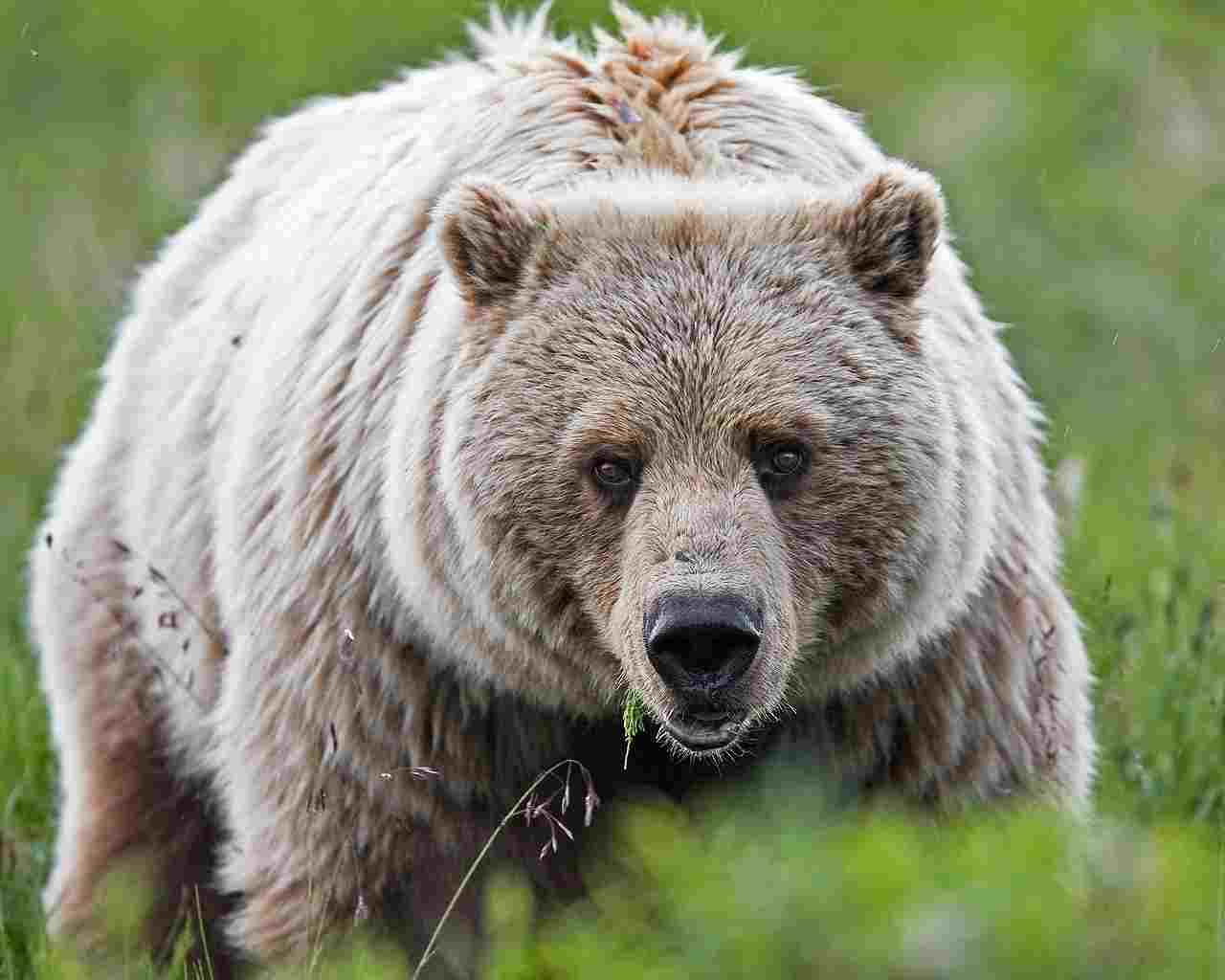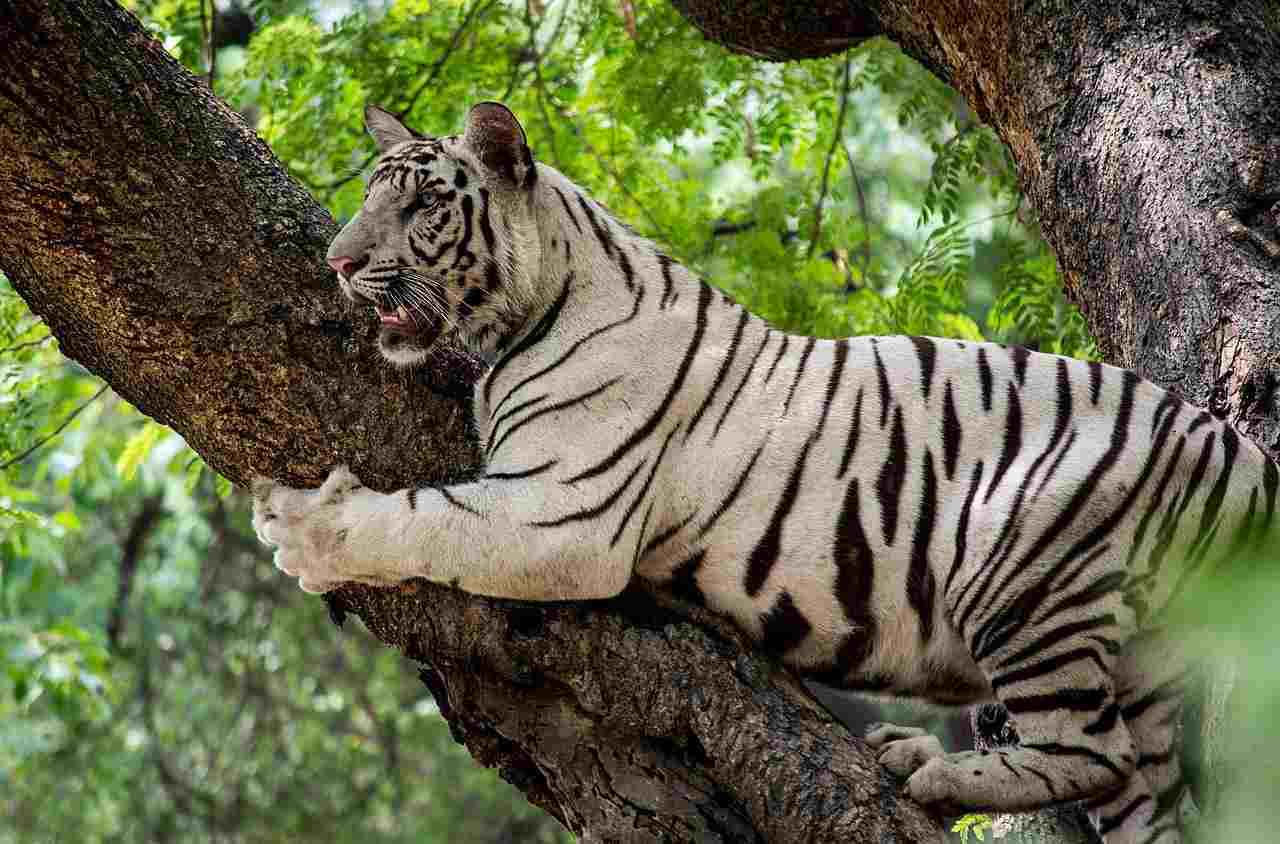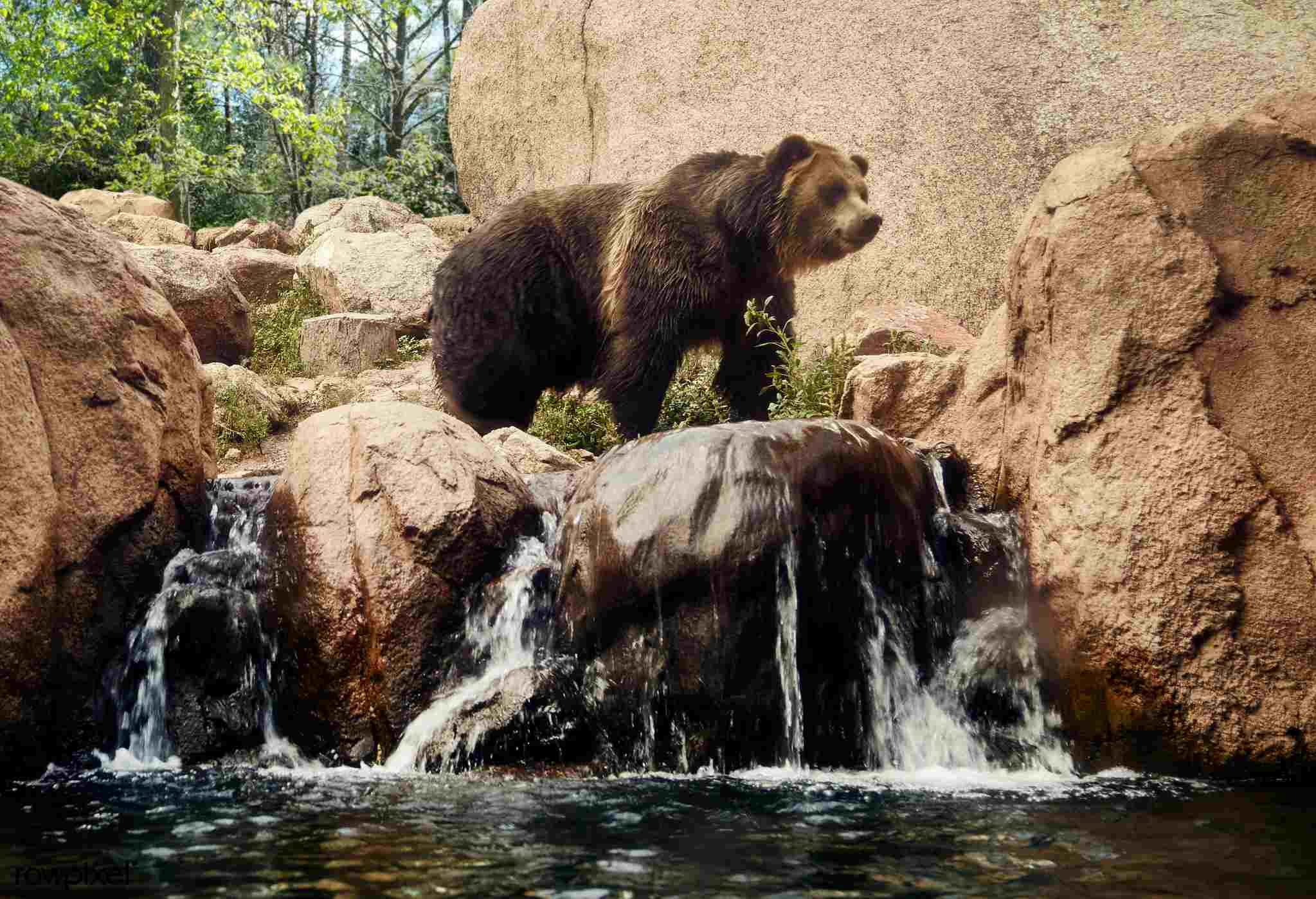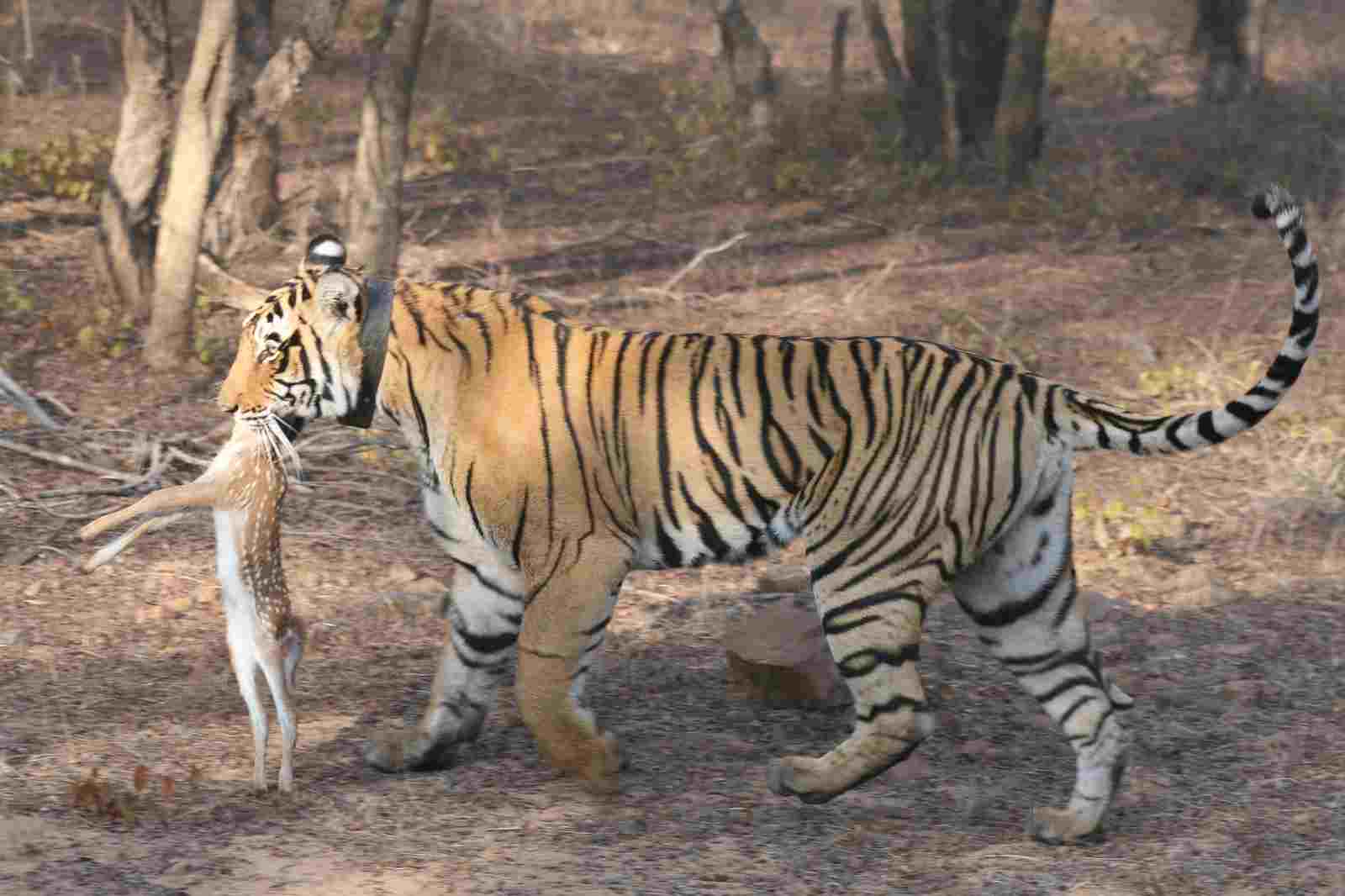Grizzly Bear Vs Tiger Size, Weight, Behavior Comparison
Grizzly bears and tigers can be compared to each other based on factors like size, weight, behavior, and more. These comparisons can help us predict the outcome of interactions between these two animals.
Key Outcomes of Comparison
A) Size:
When comparing the size of grizzly bears and tigers, it is evident that both species are formidable in their own right. Grizzly bears can reach lengths of up to 8 feet and stand at a height of 4 to 5 feet at the shoulder. Tigers, on the other hand, can grow to be around 10 feet long and stand at a height of 3 to 4 feet at the shoulder.
B) Weight:
In terms of weight, grizzly bears are known to be heavier than tigers. Adult male grizzly bears can weigh between 400 to 1,000 pounds, while adult male tigers typically weigh between 400 to 600 pounds.
C) Taxonomic Classification:
Grizzly bears belong to the Ursidae family and are classified as Ursus arctos, while tigers belong to the Felidae family and are classified as Panthera tigris.
D) Hypothetical Interaction:
In a hypothetical confrontation between a grizzly bear and a tiger, the grizzly bear would likely have the advantage due to its larger size and greater strength. However, it is important to note that such interactions are rare in the wild and are unlikely to occur naturally.
*Physical Comparison
1). Size
The size of animals plays a crucial role in determining their dominance and survival in their respective habitats. When comparing the size of a grizzly bear and a tiger, several factors need to be considered.
In terms of average height, the grizzly bear stands taller than the tiger. Adult male grizzly bears can reach a height of up to 3.3 meters (10 feet) when standing on their hind legs, while tigers typically measure around 1.2 to 1.4 meters (4 to 4.6 feet) at the shoulder.
When it comes to total body length, tigers are generally longer than grizzly bears. Adult male tigers can measure up to 3.3 meters (11 feet) from nose to tail, while grizzly bears have an average length of around 2.4 to 2.8 meters (8 to 9 feet).
In comparing the size of a grizzly bear and a tiger, it is important to note that both species can vary in size depending on factors such as age, sex, and geographical location. However, on average, grizzly bears tend to be taller, while tigers are longer.
2). Weight
When comparing the weight of a grizzly bear and a tiger, it is important to consider the average weight of both male and female individuals.
On average, male grizzly bears weigh between 400 to 790 kilograms (880 to 1,740 pounds), while female grizzly bears weigh around 130 to 200 kilograms (290 to 440 pounds). In contrast, male tigers typically weigh between 180 to 306 kilograms (400 to 675 pounds), and female tigers weigh approximately 100 to 167 kilograms (220 to 370 pounds).
In terms of sheer weight, grizzly bears are generally heavier than tigers. This can be attributed to the fact that grizzly bears have a stockier build and are adapted for a more terrestrial lifestyle, while tigers are more streamlined and agile for their arboreal and predatory habits.
However, it is important to note that individual weight can vary within each species depending on factors such as age, diet, and geographical location. Additionally, the weight of both grizzly bears and tigers can fluctuate throughout their lives due to seasonal changes and availability of food resources.

3). Skeletal Anatomy
The skeletal anatomy of a grizzly bear and a tiger reveals significant differences in their bone structure and density. Grizzly bears have a robust skeletal structure, with strong bones that are adapted for their terrestrial lifestyle. Their bones are dense and well-developed, providing them with the strength and support needed for their large size and powerful movements.
Tigers, on the other hand, have a more streamlined skeletal structure, which is lighter and designed for agility and speed. Their bones are less dense compared to grizzly bears, allowing them to be more agile and flexible in their movements.
In terms of specific skeletal differences, grizzly bears have a larger and more muscular skull compared to tigers, which is necessary to support their powerful bite force. They also have strong forelimbs and shoulder girdles, enabling them to dig, climb, and engage in other activities that require strength. Tigers, on the other hand, have elongated and flexible spines, allowing them to leap and pounce on their prey with precision. Their hind limbs are well-developed for running and jumping, providing them with the speed and agility needed for hunting.
4). Mode of Locomotion
The mode of locomotion differs significantly between grizzly bears and tigers. Grizzly bears are primarily terrestrial animals, relying on their powerful limbs to run and climb. They have a distinctive lumbering gait, with their front limbs propelling them forward while their hind limbs follow. Despite their large size, grizzly bears are surprisingly agile climbers, using their strong forelimbs and sharp claws to ascend trees in search of food or to escape danger.
On the other hand, tigers are renowned for their exceptional agility and speed. They are adept runners, capable of reaching impressive speeds in pursuit of prey. Tigers have a unique style of locomotion, known as bounding, where they leap forward with their front limbs extended before bringing their hind limbs up to meet them. This method of movement allows tigers to cover large distances quickly and efficiently.
While both grizzly bears and tigers are proficient on land, tigers also possess the ability to swim. They are excellent swimmers, using their powerful limbs and streamlined bodies to navigate through water with ease. Tigers are known to swim across rivers and lakes in search of prey or to reach new territories.
5). Speed
Grizzly bears and tigers are both impressive animals when it comes to speed, but there are some key differences between the two.
In terms of average speed, tigers have the upper hand. Tigers are known for their exceptional agility and speed, allowing them to reach impressive velocities in pursuit of prey. With their powerful muscles and streamlined bodies, tigers can sprint at speeds of up to 40 to 50 miles per hour (64 to 80 kilometers per hour). This incredible speed gives them a significant advantage when hunting, allowing them to quickly close the gap between themselves and their prey.
On the other hand, grizzly bears are not as fast as tigers. While they may not be able to match the speed of a tiger, grizzly bears can still reach a respectable pace. They can run at speeds of up to 30 miles per hour (48 kilometers per hour) for short distances. However, their larger size and more robust build make them better suited for endurance rather than outright speed.
6). Agility
When comparing the agility of grizzly bears and tigers, it is important to consider their speed and mode of locomotion. Tigers, with their sleek and muscular bodies, are renowned for their exceptional agility. This allows them to swiftly navigate through various terrains and make quick turns while chasing prey. With their ability to reach speeds of up to 40 to 50 miles per hour (64 to 80 kilometers per hour), tigers possess a remarkable level of agility that aids them in hunting effectively.
On the other hand, grizzly bears, although not as fast as tigers, still exhibit a considerable level of agility. Their larger size and more robust build may limit their speed, but they are adept at maneuvering through their environment. Grizzly bears can navigate rugged terrains, climb trees, and swim proficiently, showcasing their agility in different situations.
While tigers may have the upper hand in terms of speed, both grizzly bears and tigers possess agility that suits their respective lifestyles. Tigers rely on their agility to chase down prey, while grizzly bears utilize their agility to forage for food and navigate their habitat.
7). Relative Strength and Endurance
When comparing the relative strength and endurance of grizzly bears and tigers, several factors come into play, including muscular endurance, size, weight, and agility.
In terms of muscular endurance, tigers are known for their exceptional stamina. They can sustain high-intensity activities, such as chasing down prey, for extended periods of time. This endurance allows them to engage in prolonged hunts and increases their chances of a successful kill.
However, when considering overall strength, grizzly bears generally have the advantage. Their larger size and weight contribute to their impressive strength, enabling them to overpower prey and even take down larger animals. Grizzly bears possess powerful muscles and strong limbs, which they utilize for activities such as digging, climbing, and defending themselves.
While tigers may have superior agility, grizzly bears’ strength and endurance make them formidable opponents. Their ability to exert force and sustain physical activity for extended periods gives them an advantage in certain situations.

8). Bite force
When comparing the bite force of grizzly bears and tigers, it is important to consider their average bite force and determine which animal has a higher bite force. The bite force of an animal is a crucial factor in its hunting and feeding abilities.
Grizzly bears are known for their powerful jaws and strong bite force. With their large size and muscular build, grizzly bears can exert a significant amount of force with their bites. Their bite force allows them to crush bones and tear through tough hides, enabling them to access the nutrient-rich marrow and meat of their prey.
On the other hand, tigers also possess a formidable bite force. While they may not have the same size advantage as grizzly bears, tigers compensate with their sharp teeth and strong jaw muscles. Tigers use their bite force to deliver a swift and lethal bite to the neck or throat of their prey, effectively immobilizing it.
In a direct comparison, it is difficult to determine which animal has a higher bite force. Both grizzly bears and tigers have evolved to have powerful jaws and strong bites, tailored to their respective hunting strategies and prey. The bite force of each animal is optimized for their specific needs and is an essential tool in their survival.
9). Attack and Defense Method(s)
When comparing the attack and defense methods of grizzly bears and tigers, it is important to consider the strategies and tools each animal utilizes in order to survive and protect themselves in their respective habitats.
Grizzly bears primarily rely on their physical strength and size as a means of attack and defense. With their powerful forelimbs and sharp claws, they are capable of inflicting significant damage to potential threats. Grizzly bears also have a strong bite force, which they can use to intimidate or injure adversaries. Additionally, their thick fur and tough hide provide a certain level of protection against attacks.
On the other hand, tigers employ a combination of stealth, agility, and their sharp claws and teeth for both attack and defense. Tigers are known for their ability to silently stalk their prey, utilizing their camouflage to blend into their surroundings. When it comes to defense, tigers can use their claws and teeth to fend off attackers, delivering swift and powerful strikes. Their agility allows them to evade potential threats and escape dangerous situations.
*Hypothetical Interaction
In a hypothetical interaction between a grizzly bear and a tiger, several factors come into play that could determine the outcome of a fight. The grizzly bear, with its larger size, greater weight, and immense strength, possesses a significant advantage over the tiger. Its powerful forelimbs and sharp claws can inflict severe damage, while its strong bite force adds to its formidable arsenal. These physical attributes give the grizzly bear an edge in a potential confrontation.
On the other hand, the tiger relies on its agility, stealth, and sharp claws and teeth to hunt and defend itself. While the tiger may not match the grizzly bear in terms of size and strength, its ability to silently stalk prey and deliver swift, powerful strikes cannot be underestimated. The tiger’s agility allows it to evade potential threats and escape dangerous situations.
When comparing the grizzly bear and the tiger, it becomes clear that the grizzly bear’s size, weight, strength, and bite force give it a significant advantage in a hypothetical interaction. Yet, it is important to note that in the wild, such encounters are rare, as these animals inhabit different habitats and have distinct behaviors and hunting strategies.
*Behavioral Comparison
10). Feeding/Predation Habits
Feeding habits play a crucial role in understanding the behavior and survival strategies of animals. Both the grizzly bear and the tiger have distinct feeding habits that contribute to their respective ecological roles.
The grizzly bear is an omnivore, meaning it consumes both plant and animal matter. Its diet consists of a wide range of food sources, including berries, nuts, roots, fish, insects, and occasionally larger mammals. This versatility allows the grizzly bear to adapt to different environments and seasons, ensuring a steady food supply.
On the other hand, the tiger is a carnivore, primarily feeding on meat. Its diet mainly consists of large ungulates such as deer, wild boar, and buffalo. Tigers are skilled predators, using their powerful jaws and sharp claws to bring down their prey. They rely on stealth and ambush techniques to catch their victims, often targeting weaker or injured individuals.
11). Social Behavior
The social behavior of animals can vary greatly, with some species being solitary and others exhibiting complex social structures. Both the grizzly bear and the tiger have distinct social behaviors that contribute to their survival and reproductive success.
The grizzly bear is primarily a solitary animal, with individuals typically occupying large home ranges and avoiding direct interactions with other bears. However, there are exceptions to this behavior, particularly during the mating season when males actively seek out females. Additionally, female grizzly bears may exhibit social behavior when raising their cubs, as they provide maternal care and teach their young important survival skills.
In contrast, tigers are generally solitary animals, with individuals maintaining large territories that they mark and defend against intruders. Male tigers have overlapping territories with several females, and they may engage in social interactions during mating. However, once the mating is complete, the male tiger typically leaves the female to raise the cubs on her own.
While both the grizzly bear and the tiger exhibit solitary tendencies, the grizzly bear shows more social behavior during the mating and cub-rearing periods. This difference in social behavior may be influenced by factors such as habitat availability, resource distribution, and reproductive strategies.
12). Aggressive Tendency
The aggressive tendencies of animals can vary depending on various factors such as territoriality, competition for resources, and reproductive behavior. Both the grizzly bear and the tiger have the potential to display aggression, but the extent and triggers of their aggressive behavior differ.
Grizzly bears are generally not aggressive unless they feel threatened or their cubs are in danger. They are known to be more tolerant of humans compared to other bear species, but encounters can turn aggressive if the bear feels cornered or provoked. Factors such as food scarcity or competition for mates can also contribute to increased aggression in grizzly bears.
On the other hand, tigers are known for their aggressive nature, especially when it comes to defending their territory. They are solitary animals that mark and defend their territories against intruders, including other tigers. Tigers may display aggression when their territory is encroached upon or during mating encounters.
The triggers for aggression in grizzly bears and tigers differ due to their distinct behaviors and ecological requirements. While grizzly bears are more likely to exhibit aggression in response to immediate threats, tigers are more territorial and may display aggression to protect their resources and mating opportunities.
13). Danger to Humans (and Pets)
When it comes to the danger posed to humans and pets, both the grizzly bear and the tiger have the potential to cause harm. However, there are certain factors that make one more dangerous than the other.
The tiger is known to be more dangerous in terms of its interactions with humans and pets. Tigers have been known to attack and kill humans, especially in situations where their territory is encroached upon or when they feel threatened. They are powerful predators with the ability to take down large prey, and unfortunately, humans can sometimes be seen as potential prey.
On the other hand, while grizzly bears have the potential to harm humans and pets, they are generally less dangerous compared to tigers. Grizzly bears are known to be more tolerant of humans and are less likely to view them as prey. However, if a grizzly bear feels threatened or if its cubs are in danger, it can become aggressive and pose a danger to humans and pets in its vicinity.
13a). Likelihood of Interaction (With Humans)
The likelihood of interaction with humans differs between grizzly bears and tigers. Grizzly bears are more commonly found around human settlements compared to tigers. This is mainly due to the fact that grizzly bears have adapted to living in close proximity to human populations, especially in areas where their natural habitat has been encroached upon. They are known to scavenge for food in garbage dumps and can be attracted to human settlements by the presence of easily accessible food sources.
On the other hand, tigers tend to avoid human settlements and are more commonly found in remote forested areas. They have a larger home range and require vast territories to hunt and establish their territories. Therefore, the likelihood of encountering a grizzly bear near human settlements is higher compared to encountering a tiger.
13b). Precautionary Measure(s)
If you encounter a grizzly bear or a tiger, it is important to take precautionary measures to ensure your safety. When encountering a grizzly bear, it is recommended to stay calm and avoid direct eye contact. Slowly back away and give the bear space to retreat. If the bear charges, stand your ground and use bear spray if available.
In the case of a tiger encounter, it is crucial to maintain eye contact and make yourself appear larger by raising your arms or opening your jacket. Avoid turning your back or running away, as this may trigger the tiger’s predatory instincts. Carry a deterrent such as a loud whistle or air horn to scare off the tiger.
*Ecological Comparison
14). Taxonomic Classification
The taxonomic classification of the grizzly bear and the tiger reveals their evolutionary relationship and highlights their similarities and differences. The grizzly bear belongs to the genus Ursus and the species arctos horribilis, while the tiger belongs to the genus Panthera and the species tigris. Despite their distinct classifications, both species are part of the larger family of mammals and share common ancestry.
The taxonomic classification implies that the grizzly bear and the tiger are not closely related, as they belong to different genera and species. However, they do share certain characteristics and behaviors that can be compared and contrasted.
When comparing the grizzly bear and the tiger, their taxonomic classification provides a foundation for understanding their evolutionary history and the unique adaptations that have allowed them to thrive in their respective habitats. By examining their taxonomic relationships, we can gain insights into their physical attributes, behavior, and ecological roles.
15). Skin/Coat Texture, Camouflage
The skin and coat texture, color, and camouflage of the grizzly bear and the tiger are fascinating aspects to compare. Both species have unique adaptations that help them blend into their respective environments.
The grizzly bear’s skin is covered in thick, shaggy fur that varies in color from light brown to dark brown. This coloration allows them to blend in with the forested areas where they typically reside. The texture of their fur provides insulation and protection from the elements, making them well-suited for colder climates.
On the other hand, the tiger’s skin is covered in short, dense fur that is typically orange with black stripes. This distinctive pattern helps them camouflage in the grasslands and forests where they are found. The texture of their fur is smooth and sleek, allowing them to move silently through their environment.
While both the grizzly bear and the tiger have unique skin and coat characteristics, their adaptations serve different purposes. The grizzly bear’s fur provides insulation and protection, while the tiger’s stripes help them blend into their surroundings and remain hidden from prey or potential threats.
16). Reproduction
When it comes to reproduction, the grizzly bear and the tiger have distinct differences. The grizzly bear is a viviparous mammal, meaning that it gives birth to live young. After a gestation period of about 6 to 8 months, female grizzly bears typically give birth to one to four cubs in a den. The cubs are born blind and hairless, and they rely on their mother for nourishment and protection.
On the other hand, the tiger is also a viviparous mammal, but with a longer gestation period of about 3 to 4 months. Female tigers give birth to a litter of two to six cubs in a secluded den. The cubs are born with their eyes closed and are covered in a soft layer of fur. They depend on their mother for survival during their early stages of life.
While both the grizzly bear and the tiger have viviparous modes of reproduction, there are differences in the number of offspring and the gestation period. The grizzly bear typically has fewer cubs and a longer gestation period compared to the tiger. These variations in reproductive strategies are influenced by the species’ ecological and environmental factors.
17). Lifespan
The lifespan of both the grizzly bear and the tiger varies depending on their environment and captivity. In the wild, grizzly bears have an average lifespan of around 20 to 25 years. However, some individuals have been known to live up to 30 years or more. On the other hand, tigers in the wild generally have a shorter lifespan, with an average of 10 to 15 years. However, there have been reports of tigers living up to 20 years in the wild.
In captivity, both grizzly bears and tigers tend to have longer lifespans compared to their wild counterparts. Grizzly bears can live up to 35 years or more in captivity, while tigers have been known to live up to 25 years or more. The controlled environment, regular veterinary care, and access to a consistent food supply contribute to their extended lifespans.
When comparing the lifespans of grizzly bears and tigers, it is important to consider the factors that influence their longevity. These factors include genetics, diet, habitat quality, and human intervention. While grizzly bears generally have a longer lifespan than tigers, it is crucial to note that individual variations and specific circumstances can impact the lifespan of both species.

18). Habitat
The habitat of grizzly bears and tigers differs significantly due to their distinct geographic ranges. Grizzly bears are primarily found in North America, inhabiting a variety of ecosystems such as forests, mountains, and tundra regions. They are adaptable and can thrive in different habitats, including coastal areas and alpine meadows. Grizzly bears are known to prefer areas with dense vegetation for cover and access to food sources like berries, nuts, and fish.
On the other hand, tigers are native to Asia and are found in diverse habitats ranging from tropical rainforests to mangrove swamps and grasslands. They are highly adaptable predators and can survive in a wide range of environments, including high altitudes and dense jungles. Tigers require habitats with ample prey populations, such as deer, wild boar, and other ungulates.
While both grizzly bears and tigers can inhabit forests, their specific habitat preferences and geographic ranges differ. Grizzly bears are more commonly associated with North American wilderness, while tigers are iconic inhabitants of Asian landscapes. These distinct habitats shape their behaviors, hunting strategies, and interactions with other species in their respective ecosystems.
19). Geographic Range
The geographic range of grizzly bears and tigers is distinct, with each species occupying different regions of the world. Grizzly bears are primarily found in North America, inhabiting various ecosystems such as forests, mountains, and tundra regions. They are well-adapted to the diverse landscapes of this continent, from the dense forests of the Pacific Northwest to the vast open spaces of the Canadian Rockies. On the other hand, tigers are native to Asia and can be found in a wide range of habitats, including tropical rainforests, mangrove swamps, and grasslands. They are known to roam across countries like India, Russia, and Indonesia.
Due to their distinct geographic ranges, the chances of grizzly bears and tigers crossing paths in nature are extremely low. While both species are apex predators in their respective habitats, their territories rarely overlap. Grizzly bears are not found in Asia, and tigers are not found in North America. However, it is interesting to compare the adaptations and behaviors of these two powerful predators, as they have evolved to thrive in different environments and face unique challenges.
20). Ecologic Importance
The ecologic importance of both grizzly bears and tigers cannot be overstated. These apex predators play crucial roles in their respective ecosystems, contributing to the balance and health of the natural world.
Grizzly bears, with their omnivorous diet, have a significant impact on their environment. They are known to regulate prey populations, such as elk and salmon, through predation.
By controlling the numbers of these herbivores, grizzly bears help maintain the health of plant communities and prevent overgrazing. Additionally, their feeding habits also contribute to nutrient cycling, as they consume a variety of plant and animal matter and disperse seeds through their scat.
Similarly, tigers have a vital role in the ecosystems they inhabit. As top predators, they help control the populations of herbivores like deer and wild boar, preventing overgrazing and maintaining the balance of the food chain. Tigers also play a crucial role in shaping the structure of their habitats by influencing the behavior and distribution of their prey. Their presence helps maintain the diversity and stability of the ecosystems they inhabit.
Both grizzly bears and tigers are keystone species, meaning their presence has a disproportionate impact on the overall ecosystem. Their conservation is essential not only for their own survival but also for the preservation of the intricate web of life they are a part of.

21). Conservation Status
The conservation status of both grizzly bears and tigers is a matter of concern due to their threatened or endangered status. These iconic species face numerous challenges that put their survival at risk.
Grizzly bears, classified as a species of “least concern” by the International Union for Conservation of Nature (IUCN), still face significant threats. Habitat loss and fragmentation due to human activities, such as logging and urban development, pose a major risk to their populations.
Additionally, conflicts with humans, including poaching and illegal hunting, further contribute to their decline. Efforts are being made to protect and restore their habitats, implement stricter regulations against hunting, and promote coexistence between humans and grizzly bears.
Tigers, on the other hand, are classified as an endangered species by the IUCN. Their populations have drastically declined due to habitat loss, primarily caused by deforestation and conversion of land for agriculture. Illegal wildlife trade, driven by demand for tiger parts and products, also poses a significant threat. Conservation initiatives focus on protecting and restoring tiger habitats, strengthening anti-poaching efforts, and raising awareness about the importance of tiger conservation.
Both grizzly bears and tigers require ongoing conservation efforts to ensure their survival. Collaborative approaches involving governments, conservation organizations, local communities, and the public are crucial in addressing the complex challenges they face.
22). Main Threats to Survival
The main threats to the survival of both grizzly bears and tigers are a result of human activities and habitat loss.
For grizzly bears, the primary threat is habitat loss and fragmentation due to human activities such as logging and urban development. These activities destroy their natural habitats, disrupt their food sources, and limit their ability to roam and find mates. Additionally, conflicts with humans, including poaching and illegal hunting, pose a significant risk to their populations. These activities not only directly impact the grizzly bear population but also disrupt the delicate balance of their ecosystems.
Tigers, on the other hand, face similar challenges. The conversion of land for agriculture and deforestation are the main drivers of habitat loss for tigers. As their habitats shrink, tigers are forced into smaller and more fragmented areas, leading to increased competition for resources and a higher risk of inbreeding. Illegal wildlife trade, driven by the demand for tiger parts and products, further threatens their survival.
Conclusion
-Similarities
When comparing grizzly bears and tigers, there are several notable similarities between these two powerful creatures. Firstly, both species are known for their impressive size and weight. Grizzly bears and tigers are among the largest land predators, with adult males reaching similar dimensions. Additionally, both animals possess strong skeletal anatomy, allowing them to withstand the physical demands of their respective habitats.
In terms of behavior, grizzly bears and tigers share certain characteristics. They are solitary animals, preferring to roam and hunt alone. Both species exhibit territorial behavior, marking their territories to ward off potential threats. Furthermore, grizzly bears and tigers are highly skilled predators, relying on their agility, speed, and strength to capture their prey.
-Differences
The most significant difference between grizzly bears and tigers is their mode of locomotion. Grizzly bears are primarily terrestrial animals, adapted for walking and running on land. They have strong limbs and large, non-retractable claws that enable them to dig, climb, and grasp objects. Tigers, on the other hand, are agile and powerful swimmers.
They have streamlined bodies, webbed paws, and a layer of fat that aids in buoyancy. Tigers are known to swim long distances and are even capable of hunting in water. This difference in locomotion reflects their respective habitats and hunting strategies. Grizzly bears rely on their ability to traverse rugged terrains and chase down prey on land, while tigers utilize their swimming skills to navigate through water and ambush their prey.
-Hypothesis
Based on the physical comparison between grizzly bears and tigers, it can be hypothesized that in a violent confrontation, the grizzly bear would have the advantage due to its larger size and greater strength. Grizzly bears are known for their powerful build and muscular physique, which gives them the ability to overpower their prey and defend themselves against potential threats.
Tigers, although agile and formidable predators, may struggle to match the sheer strength and size of a grizzly bear. However, it is important to note that the outcome of such an encounter would also depend on various factors such as the environment, surprise element, and individual circumstances. Further analysis and observation are necessary to validate this.



